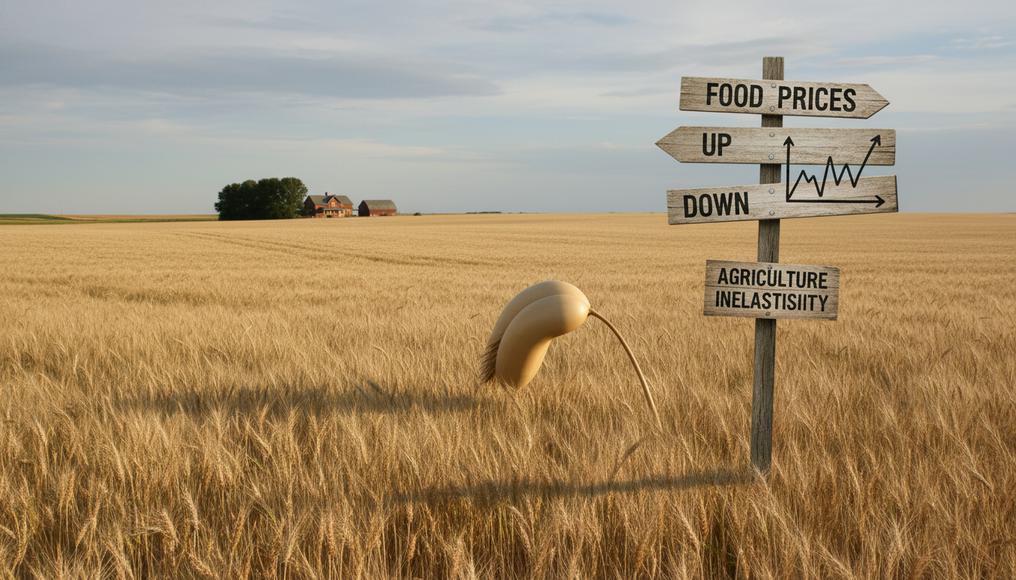@3aukcom Unlock the secrets of Price Elasticity of Supply (PES) in Economics! Discover how PES measures supply responsiveness to price changes, factors like time and spare capacity, and its impact on businesses. Visit 3auk.com for more. #aleveleconomics #pes #priceelasticity #alevels #microeconomics #alevel #ibeconomics #apmicro ♬ Elegant – Bonoy HR
Why Price Elasticity of Supply (PES) Could Become Your Go-To Economics Tool

Economics often feels overwhelming, like balancing a dozen tasks at once. But price elasticity of supply (PES) changes that by revealing why certain products face rapid price surges during shortages or why increasing production isn’t always straightforward. Consider the 2022 wheat price increase of 20% due to the Russia-Ukraine conflict, where supply only rose by 2-3%, driving up global food costs (as noted in World Bank reports). If you’re starting A-Level Economics, this guide will make PES approachable and fun, like unraveling a captivating story. For a broader introduction, check out our Econ, But Friendly: 2025–26 CAIE A‑level Economics (9708) Starter Guide. By the end, you’ll recognize PES in daily news and purchases, giving you a real edge.
– Check out our Price elasticity of demand GUIDE.
– Check out our Income elasticity of demand GUIDE.
– Check out our Cross elasticity of demand GUIDE.
Unpacking Price Elasticity of Supply: The Basics Explained

Price elasticity of supply (PES) might sound technical, but it’s essentially about how responsive producers are to price changes. It gauges the percentage shift in quantity supplied when prices fluctuate. For A-Level students new to microeconomics, PES focuses on the supply side, explaining quick increases in items like clothing versus slower responses in commodities like rare minerals used in electronics.
Unlike price elasticity of demand (PED), which tracks consumer reactions, PES highlights what suppliers can realistically provide. To deepen your understanding of the demand side, explore our guide on Understanding Price Elasticity of Demand: A Beginner’s Guide for A-Level Students. For instance, when oil prices rise, can producers extract more immediately, or are they limited by equipment? PES provides clarity on these dynamics. Understanding it helps explain business strategies and government policies, such as agricultural subsidies. It’s not about rote learning yet—just grasp that supply has limits, and PES measures that responsiveness. This concept will appear in exams, so building intuition now pays off.
In essence, PES drives the supply mechanism in markets, transforming abstract economics into relatable insights. For more on the broader price system, see our CAIE AS Level Economics: The Price System and Microeconomy – Beginner’s Essential Guide.
Mastering PES Calculations: Formula and Step-by-Step Examples

Don’t worry about the numbers—calculating price elasticity of supply (PES) is straightforward with the right approach. The formula is PES = (% Change in Quantity Supplied) / (% Change in Price), using percentages for accuracy across scales.
For reliable results, use the midpoint method: % Change = [(New Value – Old Value) / ((New Value + Old Value) / 2)] × 100. This avoids distortion. Example: If handmade candle prices rise from £4 to £5, the % change is (5-4)/((5+4)/2) × 100 ≈ 22.2%. If supply increases from 150 to 180 units (also 22.2%), PES = 1, indicating unit elasticity.
Percentages ensure fair comparisons—a small absolute change in a large market isn’t the same as in a small one. Apply this to real scenarios, like the 2022 wheat event: 20% price rise with 2% supply increase yields PES ≈ 0.1, showing inelasticity. Practice these calculations to build confidence for A-Level Economics assessments. For hands-on practice, try our CAIE AS Economics – Topic Questions.
Interpreting the PES Coefficient: What the Numbers Reveal

The PES coefficient indicates supply responsiveness, always positive since higher prices encourage more production, aligning with the law of supply. Unlike PED’s negative values, this simplifies analysis.
| PES Value | Type of Supply | Responsiveness of Quantity Supplied (QS) |
|---|---|---|
| PES > 1 | Elastic supply | QS changes more than the price. |
| PES = 1 | Unitary supply | QS changes in exact proportion to price. |
| 0 < PES < 1 | Inelastic supply | QS changes less than the price. |
| PES = 0 | Perfectly inelastic supply | QS does not change at all regardless of price. |
| PES = ∞ | Perfectly elastic supply | QS is unlimited at a fixed price. |
If PES > 1, supply is elastic—quantity changes more than price, like fast fashion adjusting to trends. PES < 1 means inelastic supply, such as limited vintage collectibles. PES = 1 is proportional. Extremes include PES = 0 (perfectly inelastic, like fixed land) and PES = ∞ (perfectly elastic, like digital goods).
This metric predicts market behavior: Elastic supply prevents extreme price volatility, while inelastic amplifies it. For businesses, high PES supports quick profit maximization. Supply curves visually represent this—flat for elastic, steep for inelastic. In A-Level Economics, it informs discussions on taxation and policy, adding depth to your understanding. To explore related supply concepts, dive into Mastering Joint Supply in A-Level Economics: From Beef to Leather Examples.
Key Factors Influencing Price Elasticity of Supply (PES)

Several elements determine PES, affecting how easily supply adjusts. Time is crucial: Short-term supply is often inelastic due to fixed constraints, but long-term allows adaptations like new facilities.
Spare capacity enables quick responses; idle resources boost PES, while full utilization creates bottlenecks. Resource mobility—switching labor or materials—enhances elasticity. Inventories act as buffers for non-perishables but not for fresh produce. The nature of inputs, like abundant versus scarce resources, and production techniques also play roles.
The 2020 semiconductor shortage exemplified low PES due to long build times and no spare capacity, leading to price hikes despite demand. In contrast, service industries like cafes show higher PES through flexible staffing. For A-Level learners, connecting these factors to examples clarifies microeconomic principles. For foundational insights on resource allocation, see our CAIE AS Level Economics: Scarcity, PPCs and Resource Allocation.
Implications of PES for Business Decisions and Market Strategies

PES directly impacts how businesses respond to price shifts. Elastic supply (PES > 1) allows rapid scaling, capturing opportunities swiftly. Inelastic supply leads to delays, potentially missing market windows.
Firms with elastic PES minimize risks in fluctuating markets, using flexible operations. Inelastic cases require planning, like diversification or advocacy for policy changes. Post-Brexit, UK manufacturers with elastic PES adapted quickly to trade shifts, increasing output by 15%. Energy sectors, however, faced challenges from inelastic constraints, resulting in import reliance.
In A-Level Economics, view PES as a strategic tool for analyzing firm behavior in competitive environments. For more on government roles, explore Government Intervention in Markets: Essential Guide for A-Level Economics Students.
Real-World Applications of PES: Examples from Daily Life and News

PES comes alive in everyday scenarios. Agriculture often shows inelastic PES; the 2022 wheat crisis saw prices rise 20% with only 2-3% supply increase (FAO data), affecting food prices globally. Manufacturing, like electronics, demonstrates elastic PES—firms ramped up production during demand spikes, stabilizing markets.
UK housing exhibits short-term inelasticity (PES ≈ 0.2 per ONS), with limited new builds despite price increases. Energy markets in 2022 highlighted inelastic PES (0.03 per IEA), causing bill surges from supply constraints. Use this to analyze current events, such as electric vehicle components.
These examples make PES relevant beyond textbooks.
Common Misconceptions About PES and Exam Preparation Tips
A frequent error is confusing PES with PED—remember, PES is positive, reflecting supply’s upward response. Another myth: PES is fixed; it varies by time frame, becoming more elastic long-term.
Avoid absolute numbers; focus on percentages. For exams, define PES clearly, explain calculations, and use factors with diagrams. Link to real examples like energy crises for evaluation. Practice midpoint formulas and curve sketches to score high in A-Level Economics. Supplement your prep with our CAIE AS Level Economics Study Notes for deeper revision.
FAQ: Essential Questions on Price Elasticity of Supply (PES)

- What distinguishes elastic and inelastic PES? Elastic (PES > 1) shows significant supply increases with price rises; inelastic (<1) has minimal changes.
- Why is PES positive? It follows the law of supply—prices and quantity supplied move together.
- Why use percentages in PES? They provide relative measures, allowing consistent comparisons across markets.
- How does PES change over time? Short-run is typically inelastic; long-run allows for elastic adjustments via investments.
- Example of perfectly inelastic PES? Land supply—prices can’t increase the amount available.
- Role of spare capacity in PES? It enables immediate supply boosts, increasing elasticity.
- Benefits of high PES for firms? Allows quick profit capture from price increases.
- PES in the 2022 energy crisis? Low PES led to sharp price rises from limited supply adjustments (IEA data).
Wrap-Up: Empower Your A-Level Economics Journey with PES
Price elasticity of supply (PES) equips you to decode market dynamics, from business tactics to policy impacts. Embrace it to excel in A-Level Economics and see economics in action everywhere.
Related articles:
– Check out our Price elasticity of demand GUIDE.
– Check out our Income elasticity of demand GUIDE.
– Check out our Cross elasticity of demand GUIDE.
References
- World Bank. (2022). Commodity Markets Outlook: The Impact of the War on Wheat Prices. https://www.worldbank.org/en/research/commodity-markets
- International Energy Agency (IEA). (2022). World Energy Outlook 2022: Gas Market Disruptions. https://www.iea.org/reports/world-energy-outlook-2022
- UK Office for National Statistics (ONS). (2023). House Price Index: Annual Trends. https://www.ons.gov.uk/economy/inflationandpriceindices/bulletins/housepriceindex/latest
- Food and Agriculture Organization (FAO). (2022). Food Outlook: Global Food Price Monitoring. https://www.fao.org/documents/card/en/c/cc0639en
- Khan Academy. (n.d.). Price Elasticity of Supply Explained. https://www.khanacademy.org/economics-finance-domain/microeconomics/elasticity-tutorial/price-elasticity-supply-tutorial/a/price-elasticity-of-supply
- Economics Help. (2023). Factors Influencing Elasticity of Supply in the UK. https://www.economicshelp.org/blog/600/economics/factors-affecting-elasticity-of-supply/
- Lumen Learning. (n.d.). Principles of Microeconomics: Calculating Elasticity. https://courses.lumenlearning.com/wm-microeconomics/chapter/calculating-elasticities/
